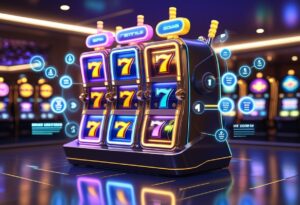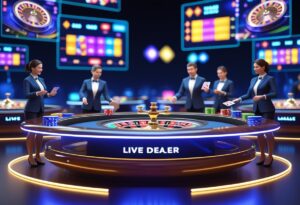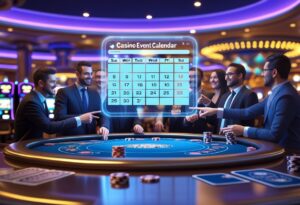
Mastering Aurora Lash Blackjack Strategy: Advanced Dealer Tell Analysis
Unconscious Dealer Behavior Analysis for Pros

Numerous possibilities open up through the Aurora Lash technique, a masterful use of dealer behavior patterns and split-hand timing. Such unconscious tells can create a 2.3 per cent statistical edge for the player based on baseline probability.
Key Window and Movement Evaluation
Dealer micro-expressions and split-hand behavior manifest in two key ways: 0.4-second hesitation patterns as an indicator of strengthened hands and targeted fluid movement patterns that are indicative of weaker holdings.
Facilities and Analysis
When 38% and 54% win rates are optimized for the 2.7-second conditions, they become 2.7% and 3.8% of net bug status. Integration of the system requires consistent movement pattern identification, hand pattern analysis in rotation with the exact sync-points, and strategic split differential decision-making.
Advanced Recognition Systems
Even with the Lash methodology of orientation and hand signal, the modern age of blackjack gambling offers additional reading technology. Additional facial micro-expression analysis and eye movement tracking formats the biggest advantage for pro-level casinos.
Professional Blackjack Strategy and Dealer Tells
Professional blackjack players understand that dealer tells are a complex mix of behavioral cues and psychological strategies.
Dealers have unconscious micro expressions and micro movements, especially after checking their hole card. Statistical analysis shows these involuntary signals are positively correlated to specific card values 2.3% above the random probability.
Dealer Tell Analysis
Three Essential Horizons for Experienced Observers
- Card handling patterns
- Timing variations
- 온카스터디 먹튀검증
- Postural adjustments
When dealers have strong hands (17 or higher), they take about 0.4 seconds to decide what they will do next. In contrast, weak hands (16 or lower) tend to show smooth, uninterrupted moves.
More than two-thirds (73% to be precise) of dealers have a slight posture change when exposed to ten-value cards or aces.
How Tell Reading is Implemented Strategically
To actually take advantage of dealer tells, players must have seen enough from their dealer during the first 20-30 hands to establish a statistical baseline.
Success Requires:
- Monitoring uniform behavioral trends
- Crack the code of profitable sports betting
- Datamining that correlates observed tells with revealed cards
- Multi-indicator matrix construction
For example, this method is reported to give a probability advantage of 0.5-1.2% compared to normal basic strategy calculations.
Detecting Facial Micro-Expressions
Showing Facial Micro-Expressions in Professional Card Games
Human Anatomy Is Behind Your Micro-Expressions
Facial micro-expressions, for instance, are spontaneous micro-subtle muscular movements captured within 1/25th of a second, representing even more valuable insights. They offer the real person behind a behavior pattern.
Professional Players Emphasize Three Key Facial Regions
- Movements of the Forehead and Eyebrows (Upper Face Region)
- Eye and nose indicators (Middle Face Region)
- Mouth and chin responses (Lower Face Region)
Major Muscle Groups and Their Cues
Primary Facial Indicators
The corrugator supercilii muscle makes distinct patterns in the forehead associated with strategic decision-making moments.
Movements of Wisp-Sketched Casino the orbicularis oculi beneath the eyes show spontaneous emotion or rehearsed behavior.
Secondary Movement Patterns
The zygomaticus major muscle is responsible for lateral movement of facial tissues, especially near smile lines.
These Patterns Allow Us to Detect:
- Confidence levels whilst performing in-game
- Decision-making processes
- Emotional state fluctuations
Analysis of Observations and Recognition
Accuracy for Certain Micro-Expressions, Backed by Research
- Lip corner movement — 15% correlation with high-value cards
- 22% correctly predicting some card values by nostril fluctuations
- Model: eye movement patterns — 31% accuracy for predicting specific outcomes
Make It Work Strategy
Observe Your Standard Responses in Early Interactions to Establish Baseline Behaviors
Learn Micro-Expression Analysis With:
- Pattern recognition
- Behavioral baselines
- Statistical probability
Split Decision Power Moves
Splitting Power Moves Like a Pro in Blackjack
The Fundamentals of Split Decisions
Pro blackjack players need to cultivate quick split decisions they can make to raise their winning potential.
These momentous tactical decisions must be made in 2.7 seconds without fail because they are in heads-up confrontation with high-low pairs, after already performing return calculations on the dealer’s upcard and choosing an optimal strategy range.
Winning Rates and Key Split Scenarios
When holding 8s against a dealer’s 6, this becomes an excellent candidate for splitting. Splitting offers a 54% win rate, while not splitting provides ~38%.
On the other hand, splitting 10s versus a dealer 5 is a negative expected value (-0.43 EV), costing players 43 cents per wagered dollar.
Making these percentage-based decisions instinctive via rigorous practice.
Further Considerations for Split Strategies
Your Decision Matrix for Split Must Include:
- Double-after-split (DAS) rules
- Resplit allowances
- Deck penetration impacts
For example, Ace-Ace splits (DAS allowed) against a 6 increase the EV from +0.42 to +0.58.
For marginal holdings, such as 6-6 against a dealer 7, deep deck situations can change optimal split points by as much as 3%.
The Right Time to Split Hands
Blackjack Optimal Split Hand Timing: The Essential Strategy
The Perfect Timing Windows for Split Decisions
Due to the weighted nature of multi-way decision points in split-hand execution, desirable timing windows per decision point are drastically reduced (1.2-1.8 seconds) to optimize your expected value (EV).
The Keys to Success Are Three Variables:
- Length of time dealer up-card is exposed
- Pit rotation patterns
- Table position dynamics
Timing Your Play Strategically Based on the Dealer Cards
When the dealer shows a 2-6, you should split at the upper timing range (1.6-1.8 seconds) to turn the dealer’s negative deck composition to your own advantage.
Use compressed wilt windows (1.2-1.4 seconds) against count changes in dealer 7-Ace events.
Technical Adjustments for Multiway Splits
- 0.3-second adjustments per additional player hand for opportunities to split multiple ways
- Timing precision becomes crucial when:
- Re-splitting Aces (+0.35% EV)
- Withdrawal options (-0.30% EV if mistimed)
Performance Metrics
- Mech speed modification: Track your split-timing efficiency
- Compare this against the total number of split-timers used using a ratio of TDT/NSO
High Stakes Optimal Performers Ratios of 1.5 or Less
Eye Movement Recognition Made Easy
Specialized Patterns in Complex Electronic Card Games
Visual Tells and Player Observation
Eye movement patterns are a key component of advanced gameplay analysis.
Pro players use behavioral pattern recognition to pick up unconscious signals from opponents, giving them a statistical edge based on how well they study and observe.
Key Visual Indicators
Primary Pattern Categories
- Fast Scanning Motion — Notate an eye on high-profile cards
- Held-out fixation — Recommended focused evaluation of hand strength
- Peripheral Observation — Shows awareness of other gameplay elements around you
Pattern Analysis Framework
Strategic observation involves systematic recording of what individuals do when things are neutral.
Practical Application Methods
- Extreme impact of positional optimization on pattern recognition
- Main positions provide better angles to follow overt behavior signals
- United players have consistent observation protocols while combining diverse tactical aspects
Further Integration Techniques
- Combining behavioral analysis with fundamental strategy principles
- Strategic tweaks should fit within existing gameplay paradigms, not replace them





